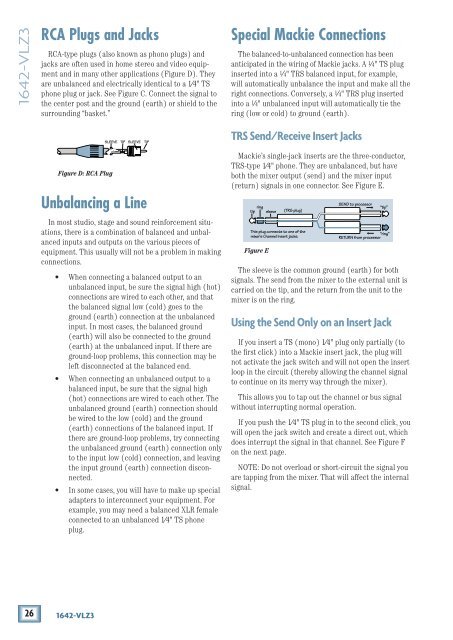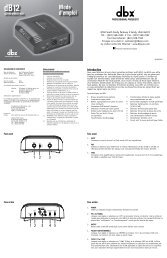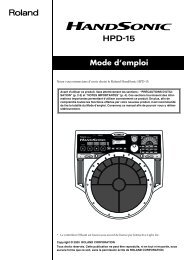1642-VLZ3 16-Channel Mic/Line Mixer Owner's Manual
1642-VLZ3 16-Channel Mic/Line Mixer Owner's Manual
1642-VLZ3 16-Channel Mic/Line Mixer Owner's Manual
Create successful ePaper yourself
Turn your PDF publications into a flip-book with our unique Google optimized e-Paper software.
<strong><strong>16</strong>42</strong>-<strong>VLZ3</strong><br />
RCA Plugs and Jacks<br />
RCA-type plugs (also known as phono plugs) and<br />
jacks are often used in home stereo and video equipment<br />
and in many other applications (Figure D). They<br />
are unbalanced and electrically identical to a 1⁄4" TS<br />
phone plug or jack. See Figure C. Connect the signal to<br />
the center post and the ground (earth) or shield to the<br />
surrounding “basket.”<br />
Special Mackie Connections<br />
The balanced-to-unbalanced connection has been<br />
anticipated in the wiring of Mackie jacks. A 1 ⁄4" TS plug<br />
inserted into a 1 ⁄4" TRS balanced input, for example,<br />
will automatically unbalance the input and make all the<br />
right connections. Conversely, a 1 ⁄4" TRS plug inserted<br />
into a 1 ⁄4" unbalanced input will automatically tie the<br />
ring (low or cold) to ground (earth).<br />
SLEEVE TIP SLEEVE<br />
TIP<br />
TRS Send/Receive Insert Jacks<br />
Figure D: RCA Plug<br />
Unbalancing a <strong>Line</strong><br />
In most studio, stage and sound reinforcement situations,<br />
there is a combination of balanced and unbalanced<br />
inputs and outputs on the various pieces of<br />
equipment. This usually will not be a problem in making<br />
connections.<br />
• When connecting a balanced output to an<br />
unbalanced input, be sure the signal high (hot)<br />
connections are wired to each other, and that<br />
the balanced signal low (cold) goes to the<br />
ground (earth) connection at the unbalanced<br />
input. In most cases, the balanced ground<br />
(earth) will also be connected to the ground<br />
(earth) at the unbalanced input. If there are<br />
ground-loop problems, this connection may be<br />
left disconnected at the balanced end.<br />
• When connecting an unbalanced output to a<br />
balanced input, be sure that the signal high<br />
(hot) connections are wired to each other. The<br />
unbalanced ground (earth) connection should<br />
be wired to the low (cold) and the ground<br />
(earth) connections of the balanced input. If<br />
there are ground-loop problems, try connecting<br />
the unbalanced ground (earth) connection only<br />
to the input low (cold) connection, and leaving<br />
the input ground (earth) connection disconnected.<br />
• In some cases, you will have to make up special<br />
adapters to interconnect your equipment. For<br />
example, you may need a balanced XLR female<br />
connected to an unbalanced 1⁄4" TS phone<br />
plug.<br />
Mackie’s single-jack inserts are the three- conductor,<br />
TRS-type 1⁄4" phone. They are unbalanced, but have<br />
both the mixer output (send) and the mixer input<br />
(return) signals in one connector. See Figure E.<br />
tip ring sleeve<br />
This plug connects to one of the<br />
mixer’s <strong>Channel</strong> Insert jacks.<br />
Figure E<br />
(TRS plug)<br />
SEND to processor<br />
The sleeve is the common ground (earth) for both<br />
signals. The send from the mixer to the external unit is<br />
carried on the tip, and the return from the unit to the<br />
mixer is on the ring.<br />
Using the Send Only on an Insert Jack<br />
If you insert a TS (mono) 1⁄4" plug only partially (to<br />
the first click) into a Mackie insert jack, the plug will<br />
not activate the jack switch and will not open the insert<br />
loop in the circuit (thereby allowing the channel signal<br />
to continue on its merry way through the mixer).<br />
This allows you to tap out the channel or bus signal<br />
without interrupting normal operation.<br />
If you push the 1⁄4" TS plug in to the second click, you<br />
will open the jack switch and create a direct out, which<br />
does interrupt the signal in that channel. See Figure F<br />
on the next page.<br />
NOTE: Do not overload or short-circuit the signal you<br />
are tapping from the mixer. That will affect the internal<br />
signal.<br />
“tip”<br />
“ring”<br />
RETURN from processor<br />
26 <strong><strong>16</strong>42</strong>-<strong>VLZ3</strong>
















